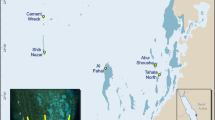Abstract
Millepora species are conspicuous members of shallow coral reefs where they occupy a variety of substrata and produce morphologically complex skeletons. This study focuses on the roles of growth on vertical and horizontal surfaces and the production of encrusting bases and branches (a “sheet-tree” morphology) for the success of the Millepora alcicornis on coral reefs. The effects of inclination were investigated by comparing the size and growth rates of M. alcicornis on vertical and horizontal surfaces at 3–5 m depth, in St. John, US Virgin Islands. The consequences of morphological complexity were investigated by comparing polyp density, chlorophyll content and biomass between encrusting bases and branches; the role of branches in asexual reproduction was also quantified. Colonies on vertical surfaces had larger encrusting bases, longer perimeters and lower densities of branches compared to those on horizontal surfaces. Growth rates also varied significantly between surfaces, largely because colonies on horizontal surfaces shrank in area while those on vertical surfaces increased in area, albeit slowly. Branches were not specialized in comparison to encrusting bases in terms of the density of dactylozooids and gastrozooids, chlorophyll content and biomass, but they were effective asexual propagules. During one storm, 79% of the branches were removed from colonies of M. alcicornis, and 4% attached to the substratum to produce new colonies at a density of ≈0.5 colonies.m-2. Anecdotal observations suggest that such storms rarely damaged encrusting bases on vertical surfaces, but often destroyed those on horizontal surfaces. Thus, the encrusting bases on vertical surfaces are likely to be large because of greater age rather than faster growth, while those on horizontal surfaces are likely to be small because they are relatively young and short lived. These findings suggest that the success of M. alcicornis is a result, in part, of the beneficial consequences of their “sheet-tree” morphology, that supports: (a) slow growth and resistance to wave damage of encrusting bases on vertical surfaces, and (b) the use of branches as asexual propagules.
Similar content being viewed by others
Author information
Authors and Affiliations
Additional information
Accepted: 24 November 1998
Rights and permissions
About this article
Cite this article
Edmunds, P. The role of colony morphology and substratum inclination in the success of Millepora alcicornis on shallow coral reefs. Coral Reefs 18, 133–140 (1999). https://doi.org/10.1007/s003380050167
Issue Date:
DOI: https://doi.org/10.1007/s003380050167




